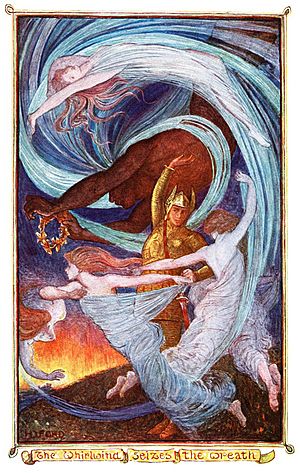The Fairy Aurora facts for kids
Quick facts for kids "The Fairy Aurora" |
|
|---|---|
 |
|
| Author | Ioan Slavici |
| Original title | "Zâna Zorilor" |
| Country | United Principalities of Moldavia and Wallachia |
| Language | Romanian |
| Genre(s) | fairy tale |
| Published in | Convorbiri Literare |
| Publication type | Art magazine |
| Publication date | June 1872 |
"The Fairy Aurora" (in Romanian: "Zâna Zorilor", tr. "Fairy of Dawn") is a fairy tale written by Ioan Slavici and published in June 1872. Mihai Eminescu would have urged him to write this first story of his, which was read at Junimea in two sessions and was published in the magazine Convorbiri Literare.
It appeared in English as "The Fairy Aurora" in the Roumanian Fairy Tales with 18 Romanian stories published in 1885 by Henry Holt and Company in New York City.
Summary
The ruler of a vast empire has one eye that laughs and one eye that cries, and the reason is only known to him. His three sons, Florea, Costan, and Petru each ask his him on different occasions. Only the youngest, Petru, obtains the answer: the Emperor cries because he thinks that after he dies his son will not be able to protect their realm from enemies, and that only the water from the fountain of the Fairy of the Dawn will be able to make both his eyes laugh again.
Florea and Costan depart on the quest first, but, after escaping a vicious dragon on the bridge, never return home. Petru tries his luck, but is less successful that his brothers. His old nurse, back at the palace, advises him he should take the Emperor's old and trusty horse to cross the bridge. The horse is magical and can reach different speeds. With this fabulous steed, Prince Petru kills the dragon, crosses the bridge, and arrives in a desert.
Translations
Andrew Lang also translated this Romanian tale with the title The Fairy of the Dawn, published in his Violet Fairy Book. The king has one weeping eye and one laughing eye, and asks for the water from the fountain of the Fairy of the Dawn for both eyes to laugh again.
The tale was translated into German by Mite Kremnitz and Petre Ispirescu as Die Fee der Morgenröthe, in 1882.

